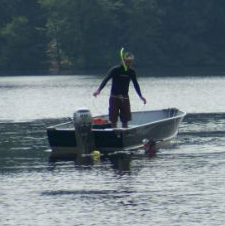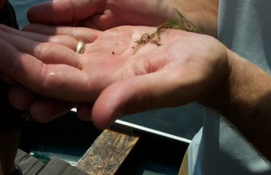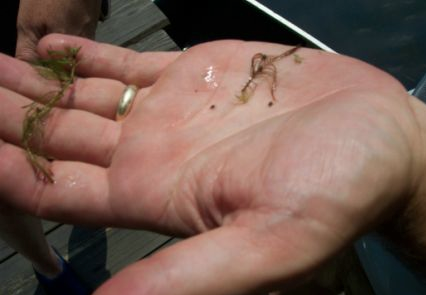milfoil AND weevils
On Wednesday, July 26 2006, some 15,000 Middfoil® Weevils were introduced to Dudley Pond. They are called Middfoil® Weevils because of the collaboration between EnviroSciences, Inc. of Ohio who grows the little critters and Middlebury College in Vermontwho has conducted years of research surrounding the viability of weevils controlling the growth of milfoil.
The weevils, attached to sprigs of milfoil, were shipped in blue coolers from Ohio on Tuesday, 7/25 and in less than 24 hours had taken up residence in Dudley Pond. Bob Hartzel of GeoSyntec Consultants and his assistant Dan arrived at the Pond at about noonand the job was done by 5PM.
The weevils were introduced into two locations in the Pond and a test site was also identified. During the remainder of the summer and next spring, sampling will be done in the two stocking sites and the test site to record the weevils’ and the milfoil’s progress.
The weevils are about the size of a head of a pin. The water in which they’re shipped is cooler than they like so they appear dormant. After several minutes in the palm of a hand, they begin to move around looking for food and shelter. The sprigs of milfoil that the weevils are bred on were attached by twist ties to plants in Dudley Pond. Once attached, they relocate to the fuller and fatter fronds of the host milfoil and they then begin their 20 – 30 day cycle of eating, laying eggs, pupating and emerging as adult weevils.
The adults eat the top of the plant, the larvae borough in and out of the stem and ultimately form a chamber which appears as a black bump on the stalk of the plant while in the pupae stage. An adult weevil ultimately reappears and the cycle repeats. From spring to early fall there typically are two or three generations working to consume as much milfoil as they can eat. In the fall when the milfoil becomes dormant, the weevils fly to shore and bury themselves in the banks where they spend the winter. In springtime, when the milfoil revives, so do the insects. They fly back to the pond weeds and continue their life cycle.
The Dudley Pond Weevil Project is only one component of The Dudley Pond Comprehensive Water Quality Improvement Project under an S319 Grant funded in part by the US Environmental Protection Agency through the Massachusetts Department of Environmental Protection. The purpose of the grant is to improve the overall quality of the water entering Dudley Pond.
The weevils, attached to sprigs of milfoil, were shipped in blue coolers from Ohio on Tuesday, 7/25 and in less than 24 hours had taken up residence in Dudley Pond. Bob Hartzel of GeoSyntec Consultants and his assistant Dan arrived at the Pond at about noonand the job was done by 5PM.
The weevils were introduced into two locations in the Pond and a test site was also identified. During the remainder of the summer and next spring, sampling will be done in the two stocking sites and the test site to record the weevils’ and the milfoil’s progress.
The weevils are about the size of a head of a pin. The water in which they’re shipped is cooler than they like so they appear dormant. After several minutes in the palm of a hand, they begin to move around looking for food and shelter. The sprigs of milfoil that the weevils are bred on were attached by twist ties to plants in Dudley Pond. Once attached, they relocate to the fuller and fatter fronds of the host milfoil and they then begin their 20 – 30 day cycle of eating, laying eggs, pupating and emerging as adult weevils.
The adults eat the top of the plant, the larvae borough in and out of the stem and ultimately form a chamber which appears as a black bump on the stalk of the plant while in the pupae stage. An adult weevil ultimately reappears and the cycle repeats. From spring to early fall there typically are two or three generations working to consume as much milfoil as they can eat. In the fall when the milfoil becomes dormant, the weevils fly to shore and bury themselves in the banks where they spend the winter. In springtime, when the milfoil revives, so do the insects. They fly back to the pond weeds and continue their life cycle.
The Dudley Pond Weevil Project is only one component of The Dudley Pond Comprehensive Water Quality Improvement Project under an S319 Grant funded in part by the US Environmental Protection Agency through the Massachusetts Department of Environmental Protection. The purpose of the grant is to improve the overall quality of the water entering Dudley Pond.


